
Skills and technology of suspension bridge construction from Nepal reaching abroad
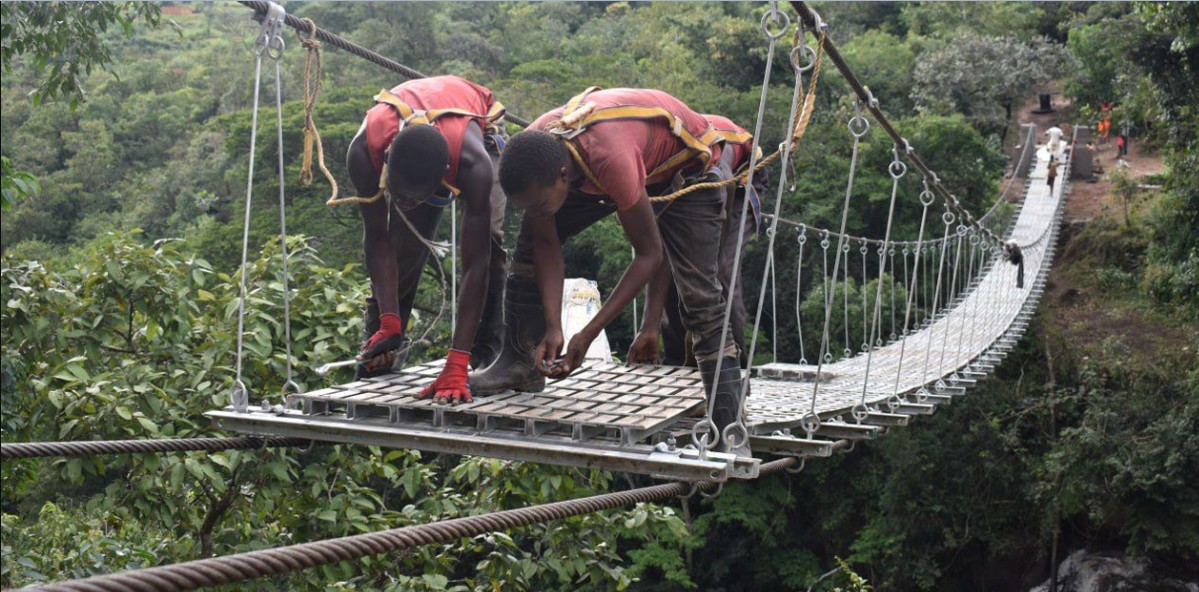
KATHMANDU: On May 19, 2025, four engineers from the African country Uganda arrived in Kathmandu. Immediately after arriving, they visited the Department of Local Infrastructure Development (DoLID) in Pulchok, Lalitpur.
Their eyes were filled with curiosity, and their notebooks contained a list of questions. Their goal was to learn the skills and technology of building Nepal’s suspension bridges. According to the department, they had been sent to Nepal by Uganda’s Ministry of Infrastructure.
The four Ugandan technicians inquired with the department officials about Nepali suspension bridges. “The team of engineers came to understand how suspension bridges are being built in Nepal and how Nepali technology can be transferred to their own country,” department spokesperson Shambhu Karki told Nepal News. “We provided them with information about the thousands of such bridges built in our country.”
Before sending them to Nepal, Uganda’s Ministry of Infrastructure had instructed them to study the effectiveness of suspension bridges built in another African country, Ethiopia.
Since 2007, Ethiopia has started adopting Nepali suspension bridge technology. By 2025, 200 bridges had already been constructed there. When the Ugandan team learned about these suspension bridges, a Nepali technician working in Ethiopia explained that the technology was Nepali, leading to conversations between the Ugandan team and the Nepali engineers constructing bridges in Ethiopia.
The Nepali engineers showed them the work of Helvetas, a Swiss non-governmental organization. Helvetas has been active in Nepal since establishing an office in Kathmandu in 1974, engaging in suspension bridge construction and related projects.
The Ugandan engineers visited Helvetas Nepal’s unit called “Track for Change,” which provides technical assistance for suspension bridges. “They came here to ask questions, and we suggested they visit Baglung district to see long and tall suspension bridges,” said Helvetas technical director Gyanendra Rajbhandari.
Afterward, they went to see a 567-meter-long suspension bridge connecting Baglung and Parbat. When returning, they even requested technical support from Helvetas Nepal, according to Rajbhandari.
He added, “Although Uganda did not formally request technical assistance from us, their deep interest in developing suspension bridge technology similar to Nepal’s was evident.”
Central and western Uganda feature hills and valleys. To connect such terrains, Uganda needs suspension bridges.
Helvetas has made significant contributions in transferring suspension bridge skills and technology to many countries worldwide. Through Helvetas, Nepali suspension bridge technology has spread to around a dozen countries so far.
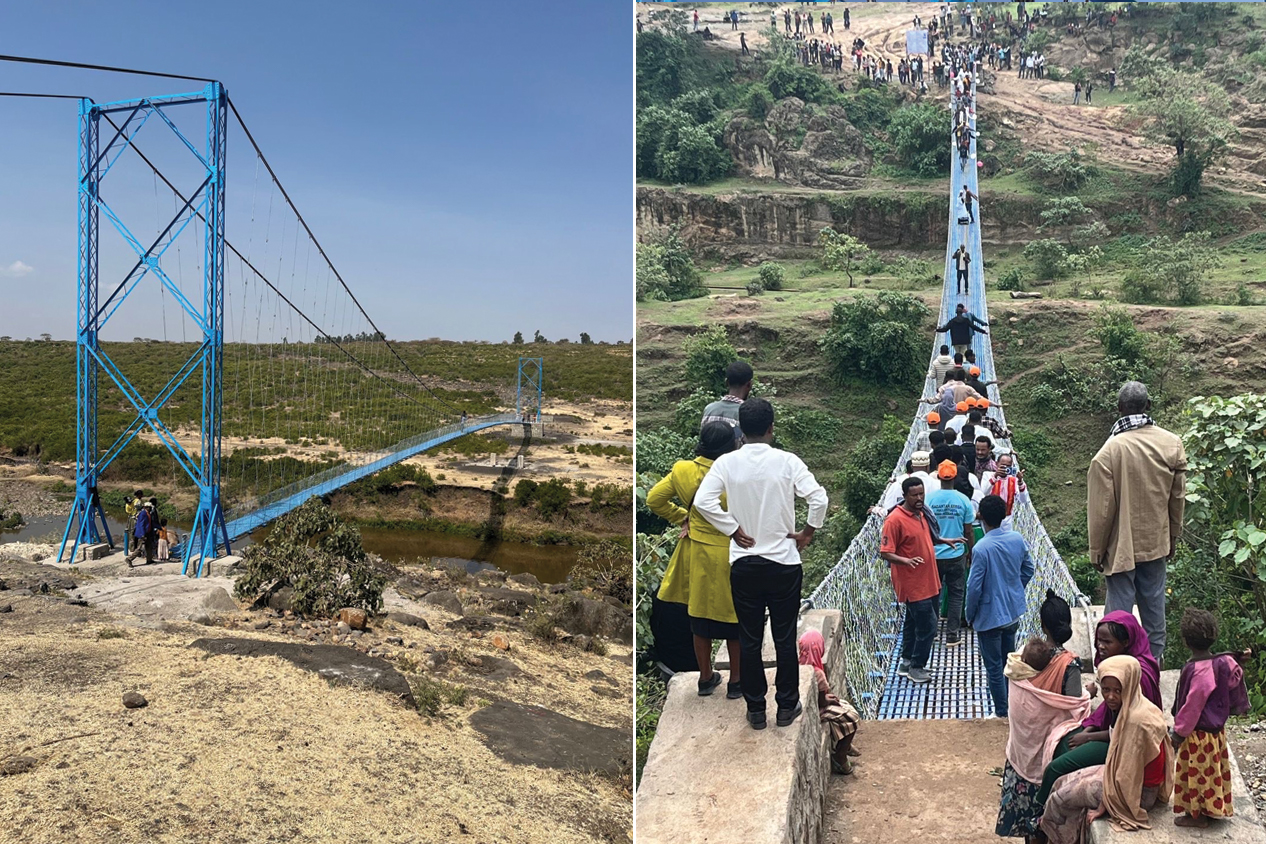
Suspension bridge in Ethiopia. Photo: Padam Bahadur Gurung
As per requests from various countries, Helvetas sends Nepali technicians to these nations. Department spokesperson Karki said, “If any skill or technology has gone from our country to others, it is the suspension bridge.”
According to Helvetas engineer Padam Gurung, working in Ethiopia’s capital Addis Ababa, suspension bridges are being built in six out of Ethiopia’s twelve states.
“Our work here involves transferring Nepali suspension bridge technology,” he said. “We train the local engineering teams, strengthen the bridge-building capacity of steel material manufacturers and contractors, and monitor construction quality while providing guidance.”
Ethiopia is eight times larger than Nepal. Geographically, it has both hilly and flat areas. So far, the bridges constructed there are shorter than 120 meters. “The Ethiopian government now plans to build bridges longer than 120 meters,” Gurung says. “They are planning bridges over large rivers where people have previously been unable to travel.”
Currently, the bridges allow the passage of people and motorcycles. Gurung says that future bridges will be able to support three-wheeled vehicles like tempos. Because travel has become easier with the bridges built so far, allowing people to conduct trade and business, the Ethiopian government is enthusiastic, Gurung adds.
Gurung also notes that he has seen areas in Ethiopia far more remote than in Nepal. He says, “To reach the places where bridges are built, one has to travel 700–800 kilometers by bus from Addis Ababa, and even after getting off the bus, one must walk for hours.”
After Ethiopia, Nepali suspension bridge technology is gradually expanding to nine countries across Southeast Asia, South America, and Africa. These countries include Bhutan, Indonesia, Laos, Honduras, Guatemala, Burundi, Tanzania, and Vietnam. Helvetas technical director Rajbhandari states that a total of 300 bridges have been built in all these countries.
In these countries, more than 15 engineers from Nepal have already provided technical assistance. Currently, three engineers are working in Ethiopia. They are sharing the knowledge and skills necessary for bridge construction with local engineers.
“A dozen countries have adopted technology from Nepal. Now Uganda is also trying to join this list,” Rajbhandari says. “In the future, Helvetas aims to bring this technology to Afghanistan and Bangladesh as well.”
Building a suspension bridge means connecting two sides, but it has also become a bridge of trust between different geographies, villages, and cities. The Nepali-developed suspension bridges are human-resource based, low-cost, time-efficient, and extremely useful for rural life.
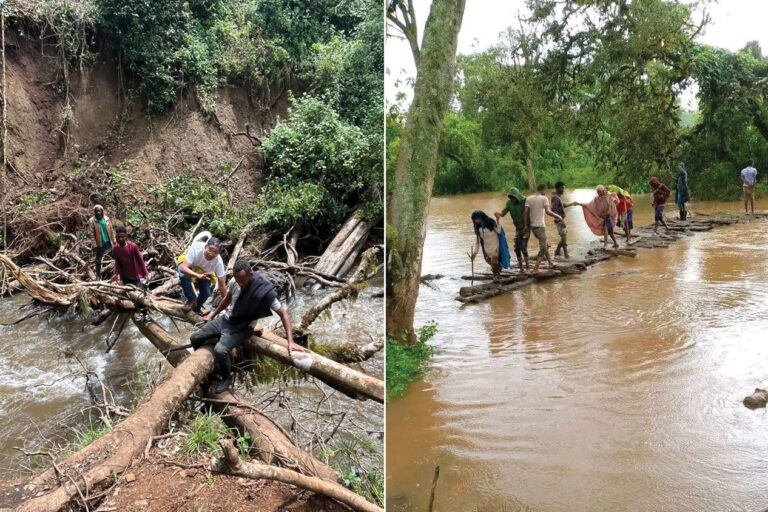
Ethiopians’ journey across the river before the bridge
Today, this technology has become a model showing developing nations that small interventions can bring significant change. “Seeing how Nepali suspension bridges have eased travel and daily life, the technology spread to countries including those in Africa, particularly giving rural African communities significant support,” Rajbhandari says.
The rods used for connecting suspension bridges in Nepal are manufactured in India and China. Nuts, bolts, iron materials, rods, and cement are sourced domestically. Currently, wherever suspension bridges are being built abroad, rods are still coming from India or China.
The demand for suspension bridges is increasing in places where road bridges cannot be built. There is also a growing practice of constructing bridges with pillars in the middle.
From 1964 to mid-July 2025, 11,427 bridges have been constructed in Nepal. According to the local Infrastructure Development Department, such bridges can be connected within 5–6 months. Constructing a 100-meter bridge costs approximately Rs 4–5 million, which is cheaper than building a road bridge with pillars in the middle.
How did suspension bridges come to Nepal?
Suspension bridges began to be built in Nepal during the Rana regime. Using materials brought from Scotland, the rulers at the time started constructing suspension bridges to connect trade routes.
More than two dozen suspension bridges built along various trade routes during that period still exist today. Rana-era bridges in Pharping, Teku, Sundarijal, and Chobhar are still in use.
After the establishment of democracy in 1950, planned development began. The First Five-Year Plan was implemented in 1956. Since Nepal lacked experience in drafting development plans, foreign experts were hired to prepare the initial framework.
During this process, Swiss geologist Tony Hagen came to Nepal. While visiting many districts to help draft development plans, he reported that the construction of “suspension bridges” was the need of the people.
Following this, the then royal government established the “Suspension Bridge Division” under the Public Works Department in 1963. After its establishment, the systematic construction of suspension bridges began in Nepal.
The Swiss government began assisting Nepal in suspension bridge construction as early as 1960. With grants from the Swiss government, Helvetas supported the Nepal government in providing technical assistance for suspension bridge construction at the local level, managing the distribution of rods, maintaining the quality of rods and bulldog grips, preparing various technical manuals, and conducting training programs.
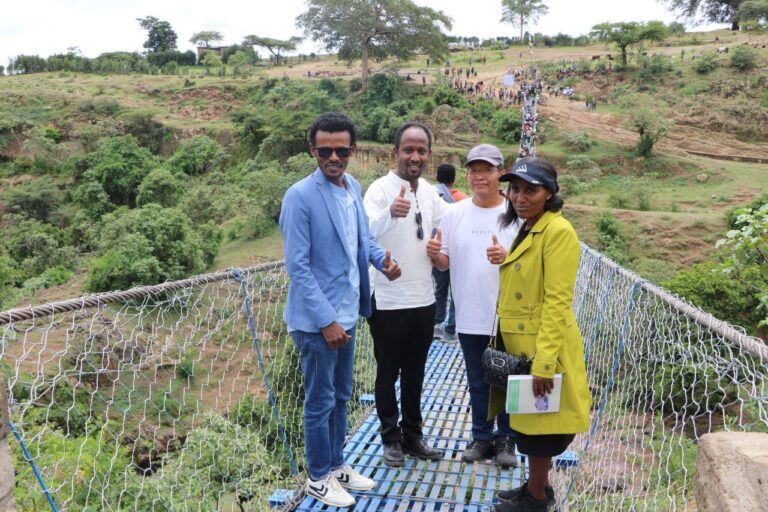
Padam Bahadur Gurung with African technicians after completion of suspension bridge in Ethiopia
Since 2023, however, Helvetas has stopped assisting the Nepal government in bridge construction. Since then, the Nepal government has been handling the work independently.
Engineers estimate that such suspension bridges have a lifespan of 50 years. “When nuts, bolts, and iron are protected from rust and properly maintained, these bridges can last for decades. The suspension bridges built during the Rana regime in Nepal are still standing,” says department engineer Humakanta Mishra.
Various types of suspension bridges: from pillars to three-way designs
Suspension bridges have been built throughout Nepal’s Terai, hills, and mountains. These bridges are designed in different ways. Many suspension bridges are constructed without pillars. Recently, the practice of building suspension bridges with pillars in the middle of rivers and streams has been increasing.
Currently, the longest suspension bridge is over the Narayani River in Susta, measuring 1,571 meters. The next longest bridge is at Chandani Dodhara over the Mahakali River, measuring 1,452 meters.
At the confluence of the Kali Gandaki River in Gulmi, Palpa, and Syangja, a three-way suspension bridge has been constructed connecting the three districts. Built over the Reedi section of the Kali Gandaki, the bridge links the religious pilgrimage sites of Palpa, Gulmi, and Syangja districts and is considered a model bridge in Nepal.
A nine-meter-diameter pillar stands at the center of the bridge. The bridge features a 25-meter-high view tower, with suspension spans of 177 meters extending in three directions to connect the three districts.
This bridge links Chandibhanyang of Kali Gandaki Rural Municipality–1 in Syangja, Argali of Tansen Municipality–14 in Palpa, and Reedi of Rurukshetra Rural Municipality–1 in Gulmi. With the bridge’s construction, pedestrians entering from any side can reach their desired district directly.
In Switzerland, short bridges are commonly built in tourist areas, and this practice has influenced bridge design in Nepal. Similar bridges have been constructed in Sanga to attract tourists.
In areas where road networks have not reached, and villages are separated by streams and rivers, suspension bridges have become a reliable means of pedestrian movement.
In districts like Jajarkot, Gorkha, Rolpa, Dolakha, Bajura, Sankhuwasabha, and Mugu, suspension bridges have helped millions of people access schools, transport patients to health posts, bring agricultural produce to markets, and participate in social activities.
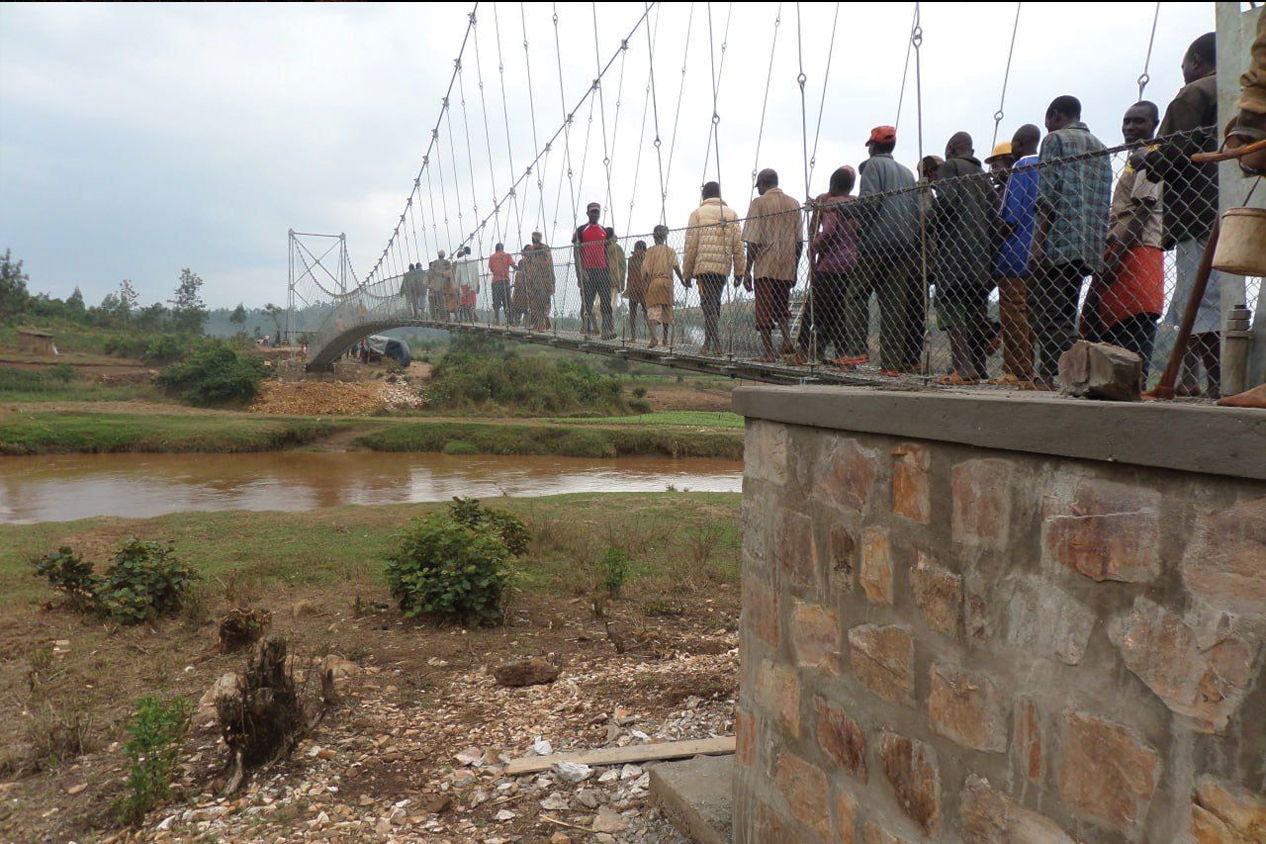
Nepali-style suspension bridge in Ethiopia. Photo: Padam Bahadur Gurung
In some locations, without bridges, reaching villages on the opposite bank required a long detour, which suspension bridges have significantly shortened in terms of distance and time.
“Before the suspension bridge was built over the Narayani River in Susta, people had to pass through Indian territory along the Gandak Canal to reach Nepal,” says Infrastructure Development Department spokesperson Karki.
The largest number of suspension bridges in Nepal are in Baglung district. With over a thousand bridges, it is often called the “district of suspension bridges.”
Basanta Kumar Shrestha, mayor of Baglung Municipality, says that suspension bridges have facilitated movement, promoted trade, and helped bring agricultural products to market.
He adds that domestic tourists are visiting the area just to see the bridges, which has boosted the local tourism business. “There are long and tall suspension bridges here, connecting one hill to another,” he says. “Although some bridges have been relocated as roads have reached more villages, their importance has not diminished.”
Today, Nepali suspension bridges are not limited to overcoming geographical barriers—they have become a model in the global development agenda for “low cost, high impact.”
Suspension bridges are neither flashy mechanical inventions nor cutting-edge technology. This simple structure, born out of Nepal’s geographical and social needs, has become a means to connect remote communities worldwide.
Helvetas engineer Gurung, working in Ethiopia, says, “Suspension bridges connect villages with markets, patients with hospitals, students with schools, and farmers with marketplaces. When this Nepali-style bridge is seen in the hills of Ethiopia, the valleys of Uganda, the rivers of Laos, or the ravines of Honduras, it is not just an expansion of engineering—it is also the export of partnership and potential.”